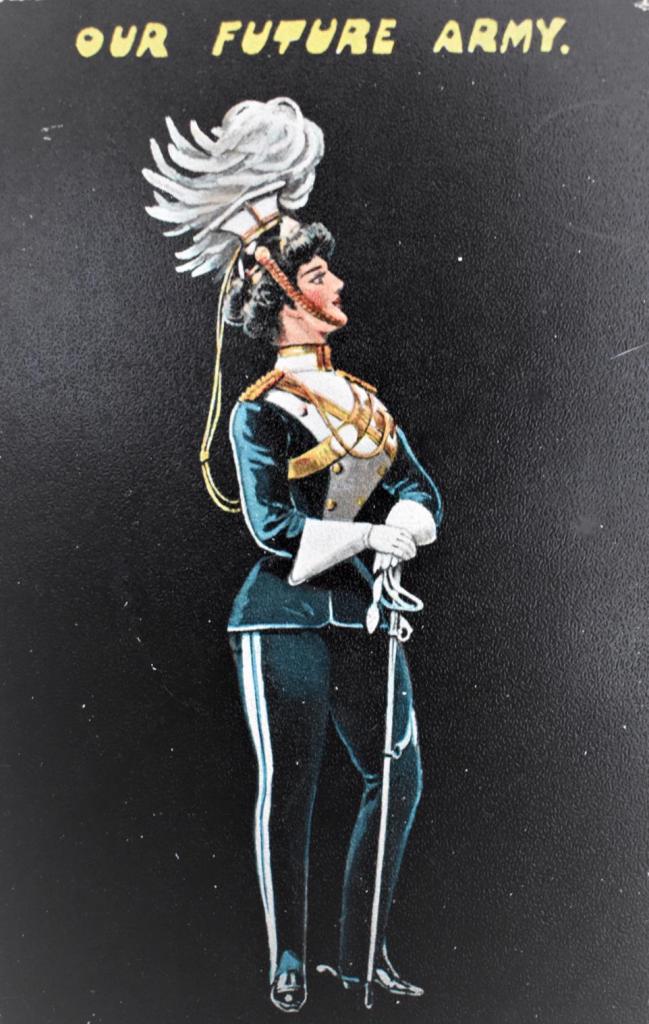What I believe to be the final card in the 120+ years old Girl Soldier postcard series finally came up for auction recently and to my delight I was the only bidder! I’d be keeping an eye out for it for a few years so there is some satisfaction to complete the set of six in total.





The final postcard I’ve been searching for represents a soldier of The Grenadier Guards, which artist Ellam puckishly calls The Grenadears.
It’s an obvious choice of regiment, Ellam’s other Soldier Girls were from either particularly famous regiments or regiments of the elite Household Division. They include:
- The 2nd Dragoons (Royal Scots Greys)
- The Royal Horse Guards (The Blues)
- The Life Guards
- A Corporal of The Gordon Highlanders
- The 12th (Prince of Wales’s) Lancers
Once again, this card is a portrayal of a confident young lady, back ramrod straight and looking up with hand on hip. Ellam drops the usual subtle clues as to her gender, these chiefly being her figure, a feminine eye and perhaps a few loose curls of hair under that bearskin.
Ellam’s other Soldier Girls had particularly accurately-depicted uniforms, so is this the case with our Guardswoman too?
Beginning with the rank markings on the arm, I can identify this Girl Soldier as being a Colour Sergeant. I include below a photographic example of these markings which closely matches the illustration by Ellam. It includes the four symbols of the home nations, the royal crown, and even the outline of the crossed sabres at the base can be vaguely discerned. Only the flagpole and tassels are missing. My copy of volume 1 of Simkin’s Soldiers (The British Army in 1890) by Col. PS Walton describes the Colour Sergeant’s markings from this era as “three gold lace chevrons edged blue on a scarlet ground with a colour badge of regimental design superimposed.”


On the collar can be seen a flaming grenade insignia, which is correct for the Grenadier Guards. The collar, cuffs, tunic front and shoulder straps are all correctly edged white but do appear almost black instead of dark blue on the postcard, but we might accord Ellam some printing issues discretion here.
I initially thought that the insignias on the collar and shoulder straps were supposed to be coloured white but for Sergeants they were indeed gold, so again Ellam is spot on. Certainly the trousers are more clearly a dark blue and they have the red stripe ending in a pair of black boots.
For the Guards regiments, a distinctive feature is the spacing of the buttons representing their place in the order of precedence (the Coldstream Guards had buttons spaced in pairs and the Scots Guards in threes, for example). The Grenadier Guards, as premier regiment, therefore had singly spaced buttons, so again we can see this is reproduced on the postcard for the regiment. Coincidentally, Simkin’s Soldiers has a photograph of a Colour-Sergeant of the Grenadier Guards.
On the bearskin, the Grenadier Guards have a white plume situated on the left hand side. As this lady has her left side facing away from us, we can only assume it’s there, so again there’s no problem there with Ellam’s depiction.
The white leather Slade-Wallace equipment drawn here was replaced by 1908 Pattern webbing. It is understood that this card series was produced approximately 1890-1900, so this equipment reflects that era. Apparently, “full equipment was worn for parades and outside barracks while a single pouch sufficed for guards and ceremonial within” (Walton). The single pouch can be seen in the Colour-Sergeant’s photograph above.
White gloves seem generally to have been worn by ranks of Sergeant and above in Review Order, which Ellam has indeed reproduced here. The wearing of white gloves by a sergeant can be seen with the man on the right in the Simkin plate below.
I’m presuming that the rifle our female Grenadier Guard holds is a .303 Lee-Metford (adopted in 1888) or possibly even its replacement the Lee-Enfield, which came into service around 1895. Here Ellam has the wooden stock ending a little too short from the barrel end for either, but would make it closer to being the Lee-Metford design.


So, there is once again no doubt as to Ellam’s dedication to regimental uniform accuracy for his cartoon series of female soldiers. This leaves me once again wondering why an apparently patronisingly ‘comic’ postcard was dedicated to such faithful uniform reproduction. Was such accuracy down to Ellam’s own interest in military uniforms or did he deliberately seek out expert advice, perhaps even from one of the great British army uniform artists of the day such as Richard Simkin, Harry Payne or Fred Stansell? I am left with speculation.
I won’t repeat here all the themes and questions I’d raised about Ellam’s depiction of these women as soldiers and why it was that ‘Ellanbee’ (publishers Landeker and Brown of London) chose this as a marketable theme, a theme copied by at least one other postcard manufacturer. Instead, with this final post on Ellanbee’s c.1900 Girl Soldier series, I’ll point anyone interested to my previous posts in this series:
- Girl Soldier (The first post on this topic featuring the Royal Horse Guard, the Gordon Highlander and the 12th Lancer).
- Trooping the Colour and a Postcard (Featuring the Life Guard in the series).
- Girl Soldier 2 (Featuring the trooper of the Scots Greys).
- Girl Soldier: The Death or Glory Girls (Also this related postcard featuring a female 17th Lancer).
































































































